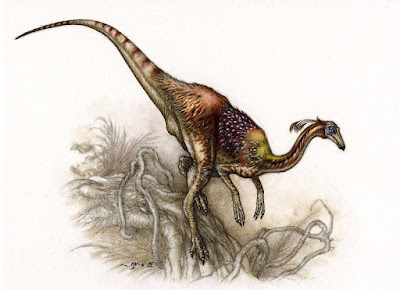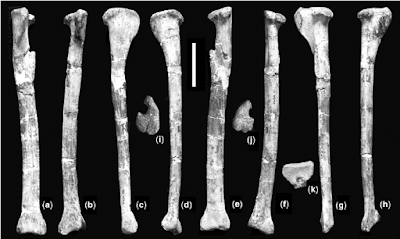[Most Recent Entries] [Calendar View]
Wednesday, February 3rd, 2016
| Time | Event | ||
| 12:21a | [Paleontology • 2009] Kinnareemimus khonkaenensis | กินรีไมมัส ขอนแก่นเอนซิส • An Early 'Ostrich Dinosaur' (Theropoda: Ornithomimosauria) from the Early Cretaceous Sao Khua Formation of NE Thailand
Abstract Postcranial remains of a small theropod dinosaur, including vertebrae, incomplete pubes, tibiae, an incomplete fibula, metatarsals and phalanges, from the Early Cretaceous Sao Khua Formation of Phu Wiang, Khon Kaen Province, NE Thailand, are described as a new taxon of ornithomimosaur, Kinnareemimus khonkaenensis, gen. et sp. nov. This early ‘ostrich dinosaur’ is characterized by a fairly advanced metatarsus, in which metatarsal III, although still visible proximally between metatarsals II and IV in cranial view, is markedly ‘pinched’ more distally and becomes triangular in cross-section. The condition of its metatarsus shows that Kinnareemimus khonkaenensis is more derived than the geologically younger primitive ornithomimosaurs Harpymimus and Garudimimus, but less derived than Archaeornithomimus. Its occurrence in the Early Cretaceous of Thailand suggests that advanced ornithomimosaurs may have originated in Asia. Buffetaut, E., Suteethorn, V. and Tong, H. 2009. An Early 'Ostrich Dinosaur' (Theropoda: Ornithomimosauria) from the Early Cretaceous Sao Khua Formation of NE Thailand. 229-243, IN E. Buffetaut, G. Cuny, J. Le Loeuff & V. Suteethorn (eds.), Late Palaeozoic and Mesozoic Ecosystems in SE Asia. Geological Society, London, Special Publications 315: 229-243. doi: 10.1144/SP315.16 | ||
| 3:38p | [Paleontology • 2016] The “χ” of the Matter: Testing the Relationship between Paleoenvironments and Three Theropod Clade
Abstract The view of spinosaurs as dinosaurs of semi-aquatic habits and strongly associated with marginal and coastal habitats are deeply rooted in both scientific and popular knowledge, but it was never statistically tested. Inspired by a previous analysis of other dinosaur clades and major paleoenvironmental categories, here we present our own statistical evaluation of the association between coastal and terrestrial paleoenvironments and spinosaurids, along with other two theropod taxa: abelisaurids and carcharodontosaurids. We also included a taphonomic perspective and classified the occurrences in categories related to potential biases in order to better address our interpretations. Our main results can be summarized as follows: 1) the taxon with the largest amount of statistical evidence showing it positively associated to coastal paleoenvironments is Spinosauridae; 2) abelisaurids and carcharodontosaurids had more statistical evidence showing them positively associated with terrestrial paleoenvironments; 3) it is likely that spinosaurids also occupied spatially inland areas in a way somehow comparable at least to carcharodontosaurids; 4) abelisaurids may have been more common than the other two taxa in inland habitats. Marcos A. F. Sales , Marcel B. Lacerda, Bruno L. D. Horn, Isabel A. P. de Oliveira and Cesar L. Schultz. 2016. The “χ” of the Matter: Testing the Relationship between Paleoenvironments and Three Theropod Clades. PLoS ONE. DOI: 10.1371/journal.pone.0147031 Buffetaut E and Suteethorn V. 1999. The dinosaur fauna of the Sao Khua Formation of Thailand and the beginning of the Cretaceous radiation of dinosaurs in Asia. Palaeogeogr Palaeoclimatol Palaeoecol. 150: 13–23. doi: 10.1016/s0031-0182(99)00004-8 Butler RJ and Barrett PM. 2008. Palaeoenvironmental controls on the distribution of Cretaceous herbivorous dinosaurs. Naturwissenschaften. 95: 1027–32. doi: 10.1007/s00114-008-0417-5. |
| << Previous Day |
2016/02/03 [Calendar] |
Next Day >> |

